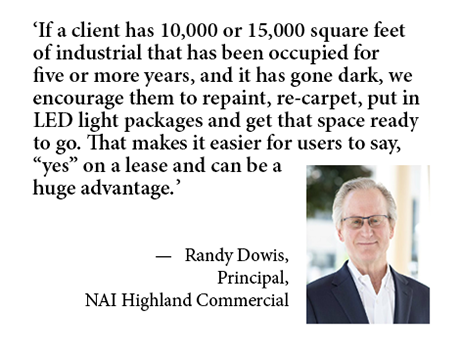Industrial activity runs a wide gamut in Colorado Springs. Situated on the busy I-25 corridor, the Centennial State’s second-largest city is a key distribution point to Northern Colorado and surrounding states. But distribution is only part of the story.
Thanks in part to Fort Carson Army base on its southern edge and the U.S. Air Force Academy to its north, the seat of El Paso County is home to an assortment of aerospace and defense manufacturers, as well as other industry clusters ranging from medical equipment makers to suppliers of semiconductor components.

“It’s a military-friendly community that offers a lot of support for entrepreneurs and families just separating from their respective branches,” says Megan Mechikoff, an associate broker specializing in industrial real estate at NAI Highland Commercial Group. “That generates a lot of startups that work directly for the Department of Defense or attach themselves to a larger brand like Lockheed Martin or Northrop Grumman.”
Colorado Springs attracts employers with its highly educated workforce, affordable cost of living and excellent quality of life, which includes mild winters on the protected Eastern slopes of the Rocky Mountains and proximity to outdoor activities and winter sports, Mechikoff says.
What Colorado Springs lacks, however, is excess industrial space or an assortment of shovel-ready development sites. That’s partly because local leaders rezoned a number of business parks for residential development and other uses more than a decade ago, says Randy Dowis, a principal at NAI Highland Commercial.
Since then, most of the market’s manufacturing and distribution construction has occurred near the airport, driven there by prohibitively high land prices elsewhere, Dowis says. Recent completions near the airport include a 3.5 million-square-foot Amazon fulfillment center that opened in 2021.
“The greater airport submarket is where almost all industrial development and industrial users have gone since 2011 because we have almost zero industrial land available in the northern part of the county,” Dowis says.
One of the exceptions to that statement is the area around I-25 and Baptist Road on the city’s north side, where Dowis and NAI’s Craig Anderson last year helped a client sell 24 acres to a Budweiser distributor for a new, 230,000-square-foot facility. This summer, UPS opened a new distribution center in the same area.
Dowis and Mechikoff contend that supply constraints that slowed the pace of development have helped Colorado Springs avoid the frothy conditions showing up in major industrial markets. The result is vacancy rates in the low single digits, regardless of property subtype. Occupiers that require modern, Class-A distribution space with 31-foot clear heights, rear loading docks, parking for long-term trailer drop-offs and enhanced security will find few options unless they arrange a build-to-suit.
From manufacturers to distribution operations, however, many occupiers continue to lease or acquire earlier-generation properties in Colorado Springs. Typical examples offer 24-foot ceilings and front-loading docks.
To help owners of older properties compete for tenants and minimize downtime between leases, NAI Highland Commercial brokers routinely advise clients to finish out vacant properties as “spec suites,” which entice users with the prospect of a rapid move-in without waiting to build out their space.
“If a client has 10,000 or 15,000 square feet of industrial space that has been occupied for five or more years, and it has gone dark, we encourage them to repaint, re-carpet, put in LED light packages and get that space ready to go,” Dowis says. “That makes it easier for users to say, ‘yes’ on a lease and can be a huge advantage. We’ve found that more than half of the time, tenants will take those spaces as-is, just to be operational sooner.”
The NAI Highland team sees room for new construction in Colorado Springs, but most will be build-to-suit projects until changes in interest rates and construction costs bring down the cost of speculative development. Any new industrial construction will focus on the high-end, high-clearance-height distribution buildings that have become state of the art everywhere.
“Developers are obviously going to build high-cube distribution product because that drives the highest lease rates, but the older properties have done fine because they offer tenants or buyers a lower cost,” Dowis says. “If you are looking at a new, high-cube space at $11 per square foot, I may be able to show you a property across the street with 24-foot clear height and 20 percent lower rent.”
That helps to explain why Colorado Springs’ high occupancy rates span industrial property subtypes and vintages.
“Older product will always have a place in the market for companies that don’t need to rack and stack inventory 30 feet high and who will take the lower lease rate and the lower ceilings,” Dowis says. “So there seems to be plenty of demand today for both new and old distribution product. I just wish I had more availability, more vacancies to offer.”
— By Matt Hudgins. This article was written in conjunction with NAI Global, a content partner of REBusinessOnline. For more articles from and news about NAI Global, click here.


